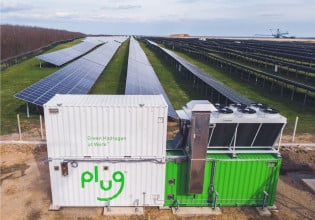Could a New Lithium-sulfur Battery Change the Future of Electrification?
Investigators from the Argonne National Laboratory unveil their latest work on developing a redox-active interlayer-based lithium-sulfur battery.
Researchers at the Argonne National Laboratory (ANL) have developed a new kind of lithium-sulfur battery (LiSB). The research builds upon existing lithium-ion battery (LiB) and LiSB technology by improving energy storage capacity and reducing polysulfide shuttling.

Lithium battery concept. Image used courtesy of Adobe Stock
LiSB Challenges
Polysulfide shuttling is a phenomenon known to occur in earlier LiSB technologies, which has hindered its widespread commercialization. It involves the migration of polysulfide species from the battery cathode to the anode, causing corrosion and reducing the battery's lifespan. This occurs due to electrolytes in LiSBs that cannot bind polysulfides, allowing them to shuttle between electrodes. The resulting corrosion can reduce battery life and performance, making it one of the main disadvantages of using LiSBs.

Microstructure and mapping of key elements (including sulfur, oxygen, and silicon) of the experimental redox-active interlayer-based LiS cell following 500 charge-discharge cycles. Image used courtesy of Guiliang Xu/ANL
Previous research involving redox-inactive interlayers yielded results concerning the partial reduction of polysulfide shuttling. Despite this, these interlayers are too heavy, sacrificing battery energy storage capacity for increased weight. Not an attractive proposition for advancing LiSB technologies.
LiSB Technology Solutions
Researchers from ANL developed a new approach to the polysulfide shuttling problem.
Instead of a redox-inactive interlayer, the researchers placed a porous redox-active interlayer containing sulfur between the battery cathode and anode.
A redox-active interlayer enables electron transfer between the battery cathode and anode. This layer helps to reduce the amount of energy lost by the battery during discharge, which makes it more efficient and longer-lasting. It also helps to improve the safety of batteries by reducing the risk of short circuits or fires due to overheating. Redox-active interlayers can be made from materials such as polymers, graphene, carbon nanotubes, and metal oxides.
In contrast to the redox-inactive interlayer, the researchers found that the redox-active interlayer reduced the shuttling effect while boosting the energy storage capacity of the LiSB.

The Advanced Photon Source at ANL. Image used courtesy of U.S. DOE ANL
During the research, experiments were conducted at the U.S. Department of Energy’s (DOE) Office of Science User Facility, the Advanced Photon Source, at a 17-BM beamline.
Compared to LiS cells with an inactive interlayer, those with an active interlayer were shown to exhibit a three-fold higher initial capacity. Additionally, cells with an active interlayer showed a discharge capacity reserve of about 64 percent following 700 charge-discharge cycles.
Future LiSB Applications
The advantages of LiSBs include higher energy density and longer cycle life than traditional LiBs. As opposed to lithium, as a resource, sulfur is more abundant and, therefore, cost-effective when concerning the manufacture and production of batteries. Another advantage of LiSBs is that they can be manufactured in existing LiB production plants.
According to Energy X, there is an estimated global lithium reserve of more than 14 million tons. According to Statista, China produced a staggering 17 million tons of sulfur in 2021 alone, followed by the U.S. at 8.1 million metric tons. A large portion of global sulfur supplies comes from its generation as a by-product of the oil and gas industry.
These factors make them an attractive choice for high-power applications that require a lot of power but need to remain lightweight and cost-effective. Examples include electric vehicles, drones, and robotics.
With continued research at ANL, the redox-active interlayer-based LiSB could provide a means of unlocking future high-power technologies.
About Argonne National Laboratory
ANL was founded in 1946 as the first national laboratory and is part of the larger U.S. Department of Energy complex. The lab focuses on research and development in energy, security, and science to address global challenges. ANL has been at the forefront of scientific discovery for over 70 years and is a leader in innovation today.






